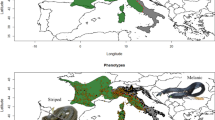Abstract
Two phenotypes—wild and axanthic—of Zamenis longissimus are found on the Roman coast. The axanthic phenotype, in the past erroneously defined as “melanotic”, owes its name to the lack of yellow sub-epidermal pigments, which allows the black effect of underlying melanophores to emerge. These dark specimens seemed to seek out damper habitats compared to those with normal pigmentation, revealing ecological polymorphism. The gradual drying of the climate must therefore have had an impact on their probable extinction (their presence was ascertained in Castelfusano–Castelporziano after 1966 and no later than 1985). In the damp zone, southeast of Torpaterno a pregnant axanthic ♀ was found, with relatively rare genetic features due to a dominant homozygous mutation, deduced from data collected from its offspring and the subsequent cross with ♂ progeny.


Similar content being viewed by others
Abbreviations
- Lt:
-
Total length
- Lc:
-
Tail length
- Rc:
-
Caudal ratio (Lt/Lc)
- P:
-
Weight
- D:
-
Number of dorsal scales at mid-trunk
- V:
-
Number of ventral scales (counted with the classical method, which considers as ventral those mid-ventral scales that are wider than they are long)
- Sc:
-
Number pairs subcaudal scales
References
Angel F (1946) Faune de France, 45. Reptiles et Amphibiens, Librairie de la Faculté des Sciences, Paris, p 204
Boulenger GA (1913) The Snakes of Europe. Methuen & Co, London, p 269
Bruno S (1984) Guida ai serpenti d’Italia. Giunti Martello, Firenze, p 191
Bruno S, Maugeri S (1990) Serpenti d’Italia e d’Europa. Mondadori, Milano, p 223
Cattaneo A (1975) Presenza di Elaphe longissima longissima (Laurenti, 1768) melanica a Castelfusano (Roma). Atti Soc ital Sci nat Museo civ Stor nat Milano 116:251–262
Cattaneo A (2005) L’erpetofauna della Tenuta Presidenziale di Castelporziano (Roma). Atti Mus Stor Nat Maremma Grosseto 21:49–77
Dobzhansky T (1951) Genetics and the origin of species, 3rd edn. Columbia University Press, New York
Dürigen B (1897) Deutschlands Amphibien und Reptilien. Creutz, Magdeburg, p 676
Erber J (1880) Einen Albino der Aesculapnatter (Elaphis Aesculapii). Verh Zool Bot Ges Wien 29:39
Ferri V, Bettiga M (1992) Un caso di albinismo nel Colubro di Esculapio, Elaphe l. longissima (Laurenti, 1768). Il Naturalista valtellinese Atti Mus civ Stor nat Morbegno 3:91–96
Froesch P (1983) Zucht und Aufzucht der Äskulapnatter, Elaphe longissima. Das Aquar Minden 170:438–442
Klingelhöffer W (1959) Terrarienkunde. Band 4: Schlangen, Skildkröten, Panzerechsen, Reptilienzucht. Kerner, Stuttgart, p 379
Kreiner G (2007) Schlangen Europas (alle Arten westlich des Kaukasus). Chimaira, Frankfurt am Main, p 317
La Greca M, Sacchi CF (1957) Problemi del popolamento animale nelle piccole isole mediterranee. Annuario Ist Mus Zool Univ Napoli 9(3):1–189
Marchi G (1901) Serpenti del Trentino. Almanacco Agrario Trento 8:362–445
Mayr E (1963) Animal species and evolution. Harvard University Press, Cambridge, Mass., pp XIV + 797
Meinig H, Schlüpmann M (1987) Herpetologische Eindrücke einer Iberienreise. Herpetof Weinst 9:11–24
Radovanović M (1941) Zur Kenntniss der Herpetofauna des Balkans. Zool Anz Jena 136:145–159
Rollinat R (1909) Note sur deux serpents albinos. Mém Soc Zool France Paris 22:143–145
Schulz KD (1996) A Monograph of the Colubrid Snakes of the Genus Elaphe Fitzinger. Koeltz Scientific Books, Havlickuv Brod, Czech Republic, III + 439 pp
Schulz KD (2013) An annotated and illustrated checklist of Old World ratsnakes. In: Schulz KD (ed) Old World ratsnakes A collection of papers. Bushmaster Publications, Berg SG, pp 17–268
Sochurek E (1955) Die Äskulapnatter. Elaphe l. longissima Laurenti, 1768 in Niederösterreich. Unsere Heimat Wien 26:180–182
Steinheil F (1913) Die europaeischen Schlangen. Fischer Jena 2:1–10
Stojanov A, Tzankov N, Naumov B (2011) Die Amphibien und Reptilien Bulgariens. Chimaira, Frankfurt am Main 588 pp
Street D (1979) Reptiles of northern and central Europe. Batsford, London 268 pp
Suzuki DT, Griffiths AJF, Miller JH, Lewontin RC (1989) An Introduction to Genetic Analysis, 4th edn. Freeman & Co, New York
Vogel Z (1968) Neue Ergebnisse über das Vorkommen der Äskulapnatter (Elaphe longissima (Laurenti)) in der Tschechoslowakei. Zool Gart Leipzig 35:166–178
Werner F (1897) Die Reptilien und Amphibien Österreich-Ungarns und der Occupationsländer. Pichler Witwe, Wien, p 160
Acknowledgments
My thanks to G. Belloni and F. Spirito of the Department of Genetics and Molecular Biology, La Sapienza University, Rome, for their precious suggestions. I also thank A. Arnone, who oversaw the translation from Italian.
Author information
Authors and Affiliations
Corresponding author
Additional information
This peer-reviewed article is a result of the multidisciplinary project coordinated by the “Accademia Nazionale delle Scienze detta dei XL”, Rome, Italy, in the area of the Presidential Estate of Castelporziano, near Rome.
Rights and permissions
About this article
Cite this article
Cattaneo, A. The Zamenis longissimus (Laurenti) axanthic phenotype found on the Castelporziano Presidential Estate: considerations on its morphology, genetic nature and probable extinction (Serpentes: Colubridae). Rend. Fis. Acc. Lincei 26 (Suppl 3), 385–389 (2015). https://doi.org/10.1007/s12210-015-0384-7
Received:
Accepted:
Published:
Issue Date:
DOI: https://doi.org/10.1007/s12210-015-0384-7




